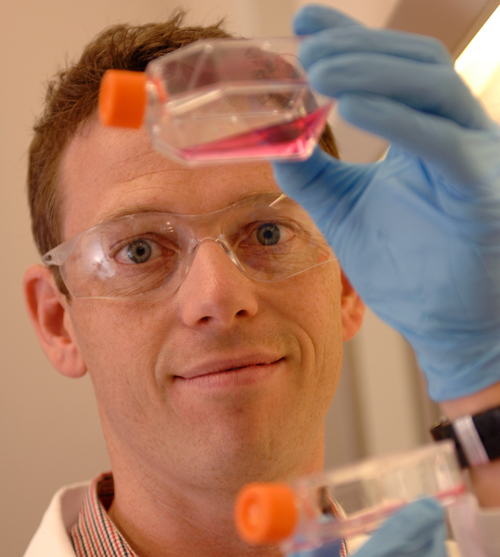
It sounds like science fiction when biomedical science professor Thomas Koch starts talking about the potential of stem cells.
Most of the cells in our body are dividing and reproducing all the time, but they create cells that are exactly like the parent cells. A muscle cell can only make more muscle cells, for example. But stem cells are unlike ordinary cells because they can give rise to many different kinds of tissues in the body. “Stem cells are amazing,” says Koch, and he should know. His cutting-edge research into isolating, extracting and using stem cells has gotten him widespread attention from both veterinary researchers and those studying human medical problems.
Koch earned his DVM from the University of Copenhagen in his native Denmark; he became interested in veterinary medicine because he had competed in show jumping and wanted to work with horses. As an undergrad, he visited OVC for three months and became interested in the internship and residency programs. He worked in private practice in Denmark for a year and a half after graduating, then returned to Guelph for an internship in large animal medicine and surgery. Once that was completed, he returned to Denmark and worked in private practice for another year before coming back to Guelph for a residency in large animal medicine.
He was able to obtain funding from the Denmark Research Council to complete his PhD at Guelph, and worked with Dean Betts (then at U of G, now at the University of Western Ontario) on a project to isolate stem cells from the umbilical cord blood of foals. “We were very successful in getting the stem cells from the cord blood and in differentiating which ones would grow bone, cartilage and other tissues,” he says. This became the topic for his PhD thesis and also gained him considerable attention: “Our study was downloaded 3,500 times in the first two weeks.”
Having finished his PhD in 2008, Koch was given another grant from the Denmark Research Council to do a three-year post-doc, in collaboration with a Danish researcher looking at human orthopaedic issues, to explore the potential for stem cells in cartilage repair. Stem cells taken from umbilical cord blood seem to be more effective in repairing damaged cartilage in joints than stem cells taken from other parts of the body such as bone marrow and fat.
He has also been studying the ways that stem cells can modulate the immune system. For example, one treatment for children who have leukemia requires that the child’s immune system be wiped out so that the child can receive bone marrow from a donor without rejecting it. Even with careful matching, though, sometimes things go wrong and the transplanted cells begin attacking the child’s tissues. This can be fatal for the child since the medications used are largely ineffective. As a last-ditch effort, some doctors have tried giving the child bone marrow stem cells, which dramatically suppressed the immune system and brought the child back.
Koch emphasizes that this is not a study, just observations of a few cases. “But there is potential,” he says. Stem cells might also prove useful for treating other health issues because they do not need to be matched as stringently as in traditional transplants. “That means we can have a cell bank, so that when a horse is brought in with a joint problem, for example, we can quickly find cells that will make the cartilage he needs.”
Working on research that promises benefits to humans as well as animals definitely helps with getting funding, Koch admits. “I am a vet, but if I can help people as well, that’s very satisfying.”
A recent major breakthrough in stem cell research involves taking an ordinary cell and re-programming it so that it behaves like a stem cell. The major advantage is that, for example, a diabetic man could have some skin cells removed, turned into stem cells, and placed in his pancreas to start making insulin without any risk of rejection.
Many of the potential uses of stem cells, such as growing hip joints that could be used in hip replacements instead of the metal joints currently used, are for non-fatal conditions. That makes it tougher to satisfy safety requirements for testing on humans, but Koch points out that if these applications for stem cells can be shown to be safe and effective in horses and dogs, getting past the regulatory barriers will be easier.
It won’t happen overnight, though. Working with stem cells is tricky. The most amazing thing about them – their ability to divide into many different types of cells – is also the biggest challenge. How do you control a stem cell? How do you make sure it develops into the kind of tissue you need? And how do you keep it from wandering off into other parts of the body and creating tumours? These are just some of the questions Koch and his colleagues are trying to answer.
In addition to his teaching and research responsibilities, Koch also assists in the Large Animal Clinic on some evenings and weekends. “I really enjoy the clinical work. Research can be a slow, drawn-out process, while treating a horse or other animal is quicker – you make the diagnosis and treat the animal and with any luck he recovers. It’s satisfying.”
While Koch finds he rarely has time to ride horses anymore, he does ride a mountain bike, and loves to spend time with his wife – a Canadian – and his two young children.
And he has a new sport, too: “I picked up hockey since coming to Canada as well,” he says. “I’m usually the best Danish player on the ice.”